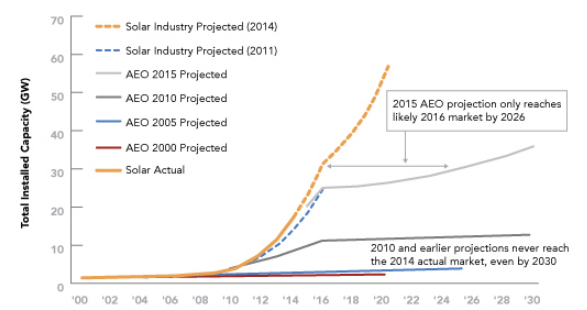
The energy market is ever changing and beholden to any number of forces, be they economic, political, practical, or personal. There are a few things we can count on, however. Among them: In advanced energy, prices are falling, and Hawaii is still sending us “postcards from the future.”
This week, Bloomberg reported that wind energy is cheaper than natural gas for Xcel Energy. Xcel, a Minneapolis-based utility that operates in eight states, including Colorado and Minnesota, is already the nation’s leading provider of wind power. On some of the windiest days, wind power supplies up to 60% of the utility’s power generation. But now it’s planning to do more, entirely on the basis of price.
In an interview with Bloomberg, Xcel’s CEO Ben Fowke said that the utility is receiving bids for 20-year power-purchase agreements at $25 per megawatt hour (MWh) for wind, which is beating out the expected price of its primary competitor in energy markets, natural gas, which is currently cheap but historically volatile in price.
“When we’re buying wind at $25, it’s a hedge against natural gas,” Fowke said in the interview. The company expects prices for natural gas-generated energy to average about $32 per MWh for the same period.
The company has plans to replace generation capacity from two retiring coal-fired units entirely with wind. Fowke said the company plans to add about 800 MW of wind capacity over the next five years. “Wind is becoming pretty close to parity,” he said.
In a recent study commissioned by AEE, The Brattle Group examined how renewable energy is being integrated into the grid, and how systems operators are maintaining reliability. The paper provided two case studies of reliability focused on utilities with high penetration of variable renewable resources, one of which was Xcel Energy Colorado. The report found that “ongoing technological progress and ongoing learning about how to manage the operations of the electric system will likely allow the integration not only of the levels of variable renewable capacity now in places like Texas and Colorado but even significantly larger amounts in the future.” You can download the paper here.
This is not the first time Xcel has opted for renewable energy based on economics. We reported that Xcel found renewable energy was “a bargain” back in 2013, and part of a much larger trend of falling prices for wind and solar while prices of fossil fuels remain volatile. The effect of that is borne out in the market: FERC’s Energy Infrastructure Update reported this week that renewable energy accounts for more than 60% of all new U.S. electrical generation installed so far in 2015, bringing total installed renewable capacity in the U.S. to 17.4%, and that doesn’t take into account distributed energy resources like rooftop solar. In fact, the government consistently underestimates the growth of renewable energy.

Distributed solar presents its own set of challenges, as Hawaii is demonstrating. Hawaii has been a leader in advanced energy, pledging to go 100% renewable by 2045 and consistently demonstrating that reduced reliance on price-volatile fossil fuels can make a grid more stable, not less. As they say, what happens in Hawaii is a “postcard from the future,” a vision of what the mainland electrical system could look like over time.
In a move heralded by the Hawaii Public Utilities Commission as the “first step in an evolution of distributed energy resource policies,” the Hawaii PUC updated its rules on net metering. Net metering is the policy by which customers with rooftop solar panels that produce more electricity than they consume at any given moment sell that electricity back to the utility at retail market prices, offsetting power purchased from the grid when the sun isn’t shining. Many utilities claim that net metering allows some consumers to be free riders on the grid – not paying for the infrastructure that keeps the lights on. Hawaii leads the nation in rooftop solar, with the highest penetration in the country by a factor of three.
In this proceeding, the Hawaii PUC ended the traditional net metering program for all new rooftop solar customers. In answer to Utility Dive’s question “What Comes After Net Metering?” the answer is two new tariffs, called the “grid-supply” and “self-supply” options. The “self-supply” option does not allow customers to sell excess electricity back to the grid and sets a $25 minimum bill each month for residential customers ($50 for small commercial customers). The “grid-supply” option credits customers a fixed rate between $0.15 and $0.28 per kilowatt-hour (kWh) – a number roughly half of retail, set to coincide with the utility’s peak avoided cost, depending on the island the customer lives on. Basically, utilities will pay the same price for distributed generation as they would for power from large solar farms,. The PUC also ordered that utilities refile time of use (TOU) proposals to provide more effective price signals for consumers to better align solar generation with the utilities peak.
So, what does this mean for solar in Hawaii (other than an “updated postcard,” as Utility Dive points out)? Greentech Media focused on the growth rate of rooftop solar, which may “hang in limbo” as a result of this ruling. The Motley Fool points out that the self-supply option may have the side effect of creating a huge new market for personal energy storage systems. The Energy Gang discussed this (as well as many other issues) with AEE Member Opower’s CEO, Dan Yates, who positioned big data and demand response as a way for utilities to better integrate distributed resources into the grid. Yates describes how Opower helps Xcel Energy “compete for their customers” as customers increasingly consider installing large solar systems to move entirely toward self-generation.
Will this new policy be a harbinger of future policy changes around net metering elsewhere? Only time will tell. In the meantime, we can be certain of two things: the price of all of these resources, from wind to solar and beyond, will continue to fall, and advanced energy will continue to bring us ever-closer to a 21st century electrical system.
Earlier this year the Advanced Energy Economy Institute commissioned The Brattle Group, a leading consulting firm to utilities and grid operators, to provide an overview of how utilities and grid operators were integrating variable renewable resources while maintaining reliable electric service. In this report, The Brattle Group provides two case studies representing the two types of electricity market structures in the United States - the Electric Reliability Council of Texas (ERCOT), a regional transmission organization (RTO), and Xcel Energy Colorado, a vertically integrated utility - each of which is successfully managing a high and increasing share of electric power from variable renewable resources. Click below to download the report.
